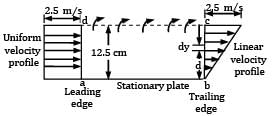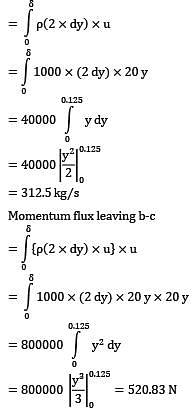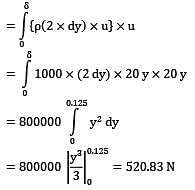Civil Engineering (CE) Exam > Civil Engineering (CE) Questions > Water flows past a flat plate, 5 m × 2 m, ke...
Start Learning for Free
Water flows past a flat plate, 5 m × 2 m, kept parallel to flow direction. The flow velocity ahead of the plate is uniform and has a value of 2.5 m⁄s. At the trailing edge, the velocity increases linearly from zero at the plate to 2.5 m⁄s at a transverse distance of 12.5 cm from it. Assuming that pressure is uniform everywhere in the flow fluid.
Calculate the drag force on the plate.
Refer Fig. for the flow past stationary plate.

Correct answer is 'Range: 259 to 261'. Can you explain this answer?
Verified Answer
Water flows past a flat plate, 5 m × 2 m, kept parallel to flow direc...
At section a-d, velocity is uniform and equal to 2.5 m ⁄ s


View all questions of this test
∴ Mass flow rate entering through a-d
= ρ × area × velocity
= 1000 (2 × 0.125) × 2.5
= 625 kg ⁄ s
Momentum flux entering a-d
= mass flow rate × velocity = 625 × 2.5 = 1526.5 N
At the training section b-c, velocity varies linearly from 0 to 2.5 m⁄s. For an elementary strip of thickness dy at transverse distance y from the plate surface, the velocity

Can be considered to be uniform ∴ Mass flow rate leaving through b-c

Momentum flux leaving b-c

No mass can enter or leave the control volume through the surface a-b. The continuity requirement then stipulates that Mass rate of outward flow through c-d = (mass rate of inflow through a-d) − (mass rate of out flow through b-c) = 625 − 312.5 = 312.5 kg ⁄ s This outward flow takes place with free stream velocity of 2.5 m ⁄ s
∴ Momentum flux leaving section c-d = 312.5 × 2.5 = 781.25 N
In the absence of any pressure and gravity forces, the force exerted by the plate must be balanced by the net momentum change.
∴ Force exerted by the plate
= 520.83 + 781.85 − 1562.5
= −260.42 N
The negative sign signifies that it acts in a direction opposite to that of water flow. The drag force exerted by water on the plate is equal and opposite to it.
Most Upvoted Answer
Water flows past a flat plate, 5 m × 2 m, kept parallel to flow direc...
At section a-d, velocity is uniform and equal to 2.5 m ⁄ s


∴ Mass flow rate entering through a-d
= ρ × area × velocity
= 1000 (2 × 0.125) × 2.5
= 625 kg ⁄ s
Momentum flux entering a-d
= mass flow rate × velocity = 625 × 2.5 = 1526.5 N
At the training section b-c, velocity varies linearly from 0 to 2.5 m⁄s. For an elementary strip of thickness dy at transverse distance y from the plate surface, the velocity

Can be considered to be uniform ∴ Mass flow rate leaving through b-c

Momentum flux leaving b-c

No mass can enter or leave the control volume through the surface a-b. The continuity requirement then stipulates that Mass rate of outward flow through c-d = (mass rate of inflow through a-d) − (mass rate of out flow through b-c) = 625 − 312.5 = 312.5 kg ⁄ s This outward flow takes place with free stream velocity of 2.5 m ⁄ s
∴ Momentum flux leaving section c-d = 312.5 × 2.5 = 781.25 N
In the absence of any pressure and gravity forces, the force exerted by the plate must be balanced by the net momentum change.
∴ Force exerted by the plate
= 520.83 + 781.85 − 1562.5
= −260.42 N
The negative sign signifies that it acts in a direction opposite to that of water flow. The drag force exerted by water on the plate is equal and opposite to it.

|
Explore Courses for Civil Engineering (CE) exam
|

|
Similar Civil Engineering (CE) Doubts
Water flows past a flat plate, 5 m × 2 m, kept parallel to flow direction. The flow velocity ahead of the plate is uniform and has a value of 2.5 m⁄s. At the trailing edge, the velocity increases linearly from zero at the plate to 2.5 m⁄s at a transverse distance of 12.5 cm from it. Assuming that pressure is uniform everywhere in the flow fluid.Calculate the drag force on the plate.Refer Fig. for the flow past stationary plate.Correct answer is 'Range: 259 to 261'. Can you explain this answer?
Question Description
Water flows past a flat plate, 5 m × 2 m, kept parallel to flow direction. The flow velocity ahead of the plate is uniform and has a value of 2.5 m⁄s. At the trailing edge, the velocity increases linearly from zero at the plate to 2.5 m⁄s at a transverse distance of 12.5 cm from it. Assuming that pressure is uniform everywhere in the flow fluid.Calculate the drag force on the plate.Refer Fig. for the flow past stationary plate.Correct answer is 'Range: 259 to 261'. Can you explain this answer? for Civil Engineering (CE) 2025 is part of Civil Engineering (CE) preparation. The Question and answers have been prepared according to the Civil Engineering (CE) exam syllabus. Information about Water flows past a flat plate, 5 m × 2 m, kept parallel to flow direction. The flow velocity ahead of the plate is uniform and has a value of 2.5 m⁄s. At the trailing edge, the velocity increases linearly from zero at the plate to 2.5 m⁄s at a transverse distance of 12.5 cm from it. Assuming that pressure is uniform everywhere in the flow fluid.Calculate the drag force on the plate.Refer Fig. for the flow past stationary plate.Correct answer is 'Range: 259 to 261'. Can you explain this answer? covers all topics & solutions for Civil Engineering (CE) 2025 Exam. Find important definitions, questions, meanings, examples, exercises and tests below for Water flows past a flat plate, 5 m × 2 m, kept parallel to flow direction. The flow velocity ahead of the plate is uniform and has a value of 2.5 m⁄s. At the trailing edge, the velocity increases linearly from zero at the plate to 2.5 m⁄s at a transverse distance of 12.5 cm from it. Assuming that pressure is uniform everywhere in the flow fluid.Calculate the drag force on the plate.Refer Fig. for the flow past stationary plate.Correct answer is 'Range: 259 to 261'. Can you explain this answer?.
Water flows past a flat plate, 5 m × 2 m, kept parallel to flow direction. The flow velocity ahead of the plate is uniform and has a value of 2.5 m⁄s. At the trailing edge, the velocity increases linearly from zero at the plate to 2.5 m⁄s at a transverse distance of 12.5 cm from it. Assuming that pressure is uniform everywhere in the flow fluid.Calculate the drag force on the plate.Refer Fig. for the flow past stationary plate.Correct answer is 'Range: 259 to 261'. Can you explain this answer? for Civil Engineering (CE) 2025 is part of Civil Engineering (CE) preparation. The Question and answers have been prepared according to the Civil Engineering (CE) exam syllabus. Information about Water flows past a flat plate, 5 m × 2 m, kept parallel to flow direction. The flow velocity ahead of the plate is uniform and has a value of 2.5 m⁄s. At the trailing edge, the velocity increases linearly from zero at the plate to 2.5 m⁄s at a transverse distance of 12.5 cm from it. Assuming that pressure is uniform everywhere in the flow fluid.Calculate the drag force on the plate.Refer Fig. for the flow past stationary plate.Correct answer is 'Range: 259 to 261'. Can you explain this answer? covers all topics & solutions for Civil Engineering (CE) 2025 Exam. Find important definitions, questions, meanings, examples, exercises and tests below for Water flows past a flat plate, 5 m × 2 m, kept parallel to flow direction. The flow velocity ahead of the plate is uniform and has a value of 2.5 m⁄s. At the trailing edge, the velocity increases linearly from zero at the plate to 2.5 m⁄s at a transverse distance of 12.5 cm from it. Assuming that pressure is uniform everywhere in the flow fluid.Calculate the drag force on the plate.Refer Fig. for the flow past stationary plate.Correct answer is 'Range: 259 to 261'. Can you explain this answer?.
Solutions for Water flows past a flat plate, 5 m × 2 m, kept parallel to flow direction. The flow velocity ahead of the plate is uniform and has a value of 2.5 m⁄s. At the trailing edge, the velocity increases linearly from zero at the plate to 2.5 m⁄s at a transverse distance of 12.5 cm from it. Assuming that pressure is uniform everywhere in the flow fluid.Calculate the drag force on the plate.Refer Fig. for the flow past stationary plate.Correct answer is 'Range: 259 to 261'. Can you explain this answer? in English & in Hindi are available as part of our courses for Civil Engineering (CE).
Download more important topics, notes, lectures and mock test series for Civil Engineering (CE) Exam by signing up for free.
Here you can find the meaning of Water flows past a flat plate, 5 m × 2 m, kept parallel to flow direction. The flow velocity ahead of the plate is uniform and has a value of 2.5 m⁄s. At the trailing edge, the velocity increases linearly from zero at the plate to 2.5 m⁄s at a transverse distance of 12.5 cm from it. Assuming that pressure is uniform everywhere in the flow fluid.Calculate the drag force on the plate.Refer Fig. for the flow past stationary plate.Correct answer is 'Range: 259 to 261'. Can you explain this answer? defined & explained in the simplest way possible. Besides giving the explanation of
Water flows past a flat plate, 5 m × 2 m, kept parallel to flow direction. The flow velocity ahead of the plate is uniform and has a value of 2.5 m⁄s. At the trailing edge, the velocity increases linearly from zero at the plate to 2.5 m⁄s at a transverse distance of 12.5 cm from it. Assuming that pressure is uniform everywhere in the flow fluid.Calculate the drag force on the plate.Refer Fig. for the flow past stationary plate.Correct answer is 'Range: 259 to 261'. Can you explain this answer?, a detailed solution for Water flows past a flat plate, 5 m × 2 m, kept parallel to flow direction. The flow velocity ahead of the plate is uniform and has a value of 2.5 m⁄s. At the trailing edge, the velocity increases linearly from zero at the plate to 2.5 m⁄s at a transverse distance of 12.5 cm from it. Assuming that pressure is uniform everywhere in the flow fluid.Calculate the drag force on the plate.Refer Fig. for the flow past stationary plate.Correct answer is 'Range: 259 to 261'. Can you explain this answer? has been provided alongside types of Water flows past a flat plate, 5 m × 2 m, kept parallel to flow direction. The flow velocity ahead of the plate is uniform and has a value of 2.5 m⁄s. At the trailing edge, the velocity increases linearly from zero at the plate to 2.5 m⁄s at a transverse distance of 12.5 cm from it. Assuming that pressure is uniform everywhere in the flow fluid.Calculate the drag force on the plate.Refer Fig. for the flow past stationary plate.Correct answer is 'Range: 259 to 261'. Can you explain this answer? theory, EduRev gives you an
ample number of questions to practice Water flows past a flat plate, 5 m × 2 m, kept parallel to flow direction. The flow velocity ahead of the plate is uniform and has a value of 2.5 m⁄s. At the trailing edge, the velocity increases linearly from zero at the plate to 2.5 m⁄s at a transverse distance of 12.5 cm from it. Assuming that pressure is uniform everywhere in the flow fluid.Calculate the drag force on the plate.Refer Fig. for the flow past stationary plate.Correct answer is 'Range: 259 to 261'. Can you explain this answer? tests, examples and also practice Civil Engineering (CE) tests.

|
Explore Courses for Civil Engineering (CE) exam
|

|
Signup for Free!
Signup to see your scores go up within 7 days! Learn & Practice with 1000+ FREE Notes, Videos & Tests.


























